Check out our own Fraser Cain and the scientists from the New Horizon team as they discuss the imminent arrival of the New Horizons spacecraft at Pluto!
Watch the hangout here and subscribe to the New Horizons YouTube Channel!
Check out our own Fraser Cain and the scientists from the New Horizon team as they discuss the imminent arrival of the New Horizons spacecraft at Pluto!
Watch the hangout here and subscribe to the New Horizons YouTube Channel!
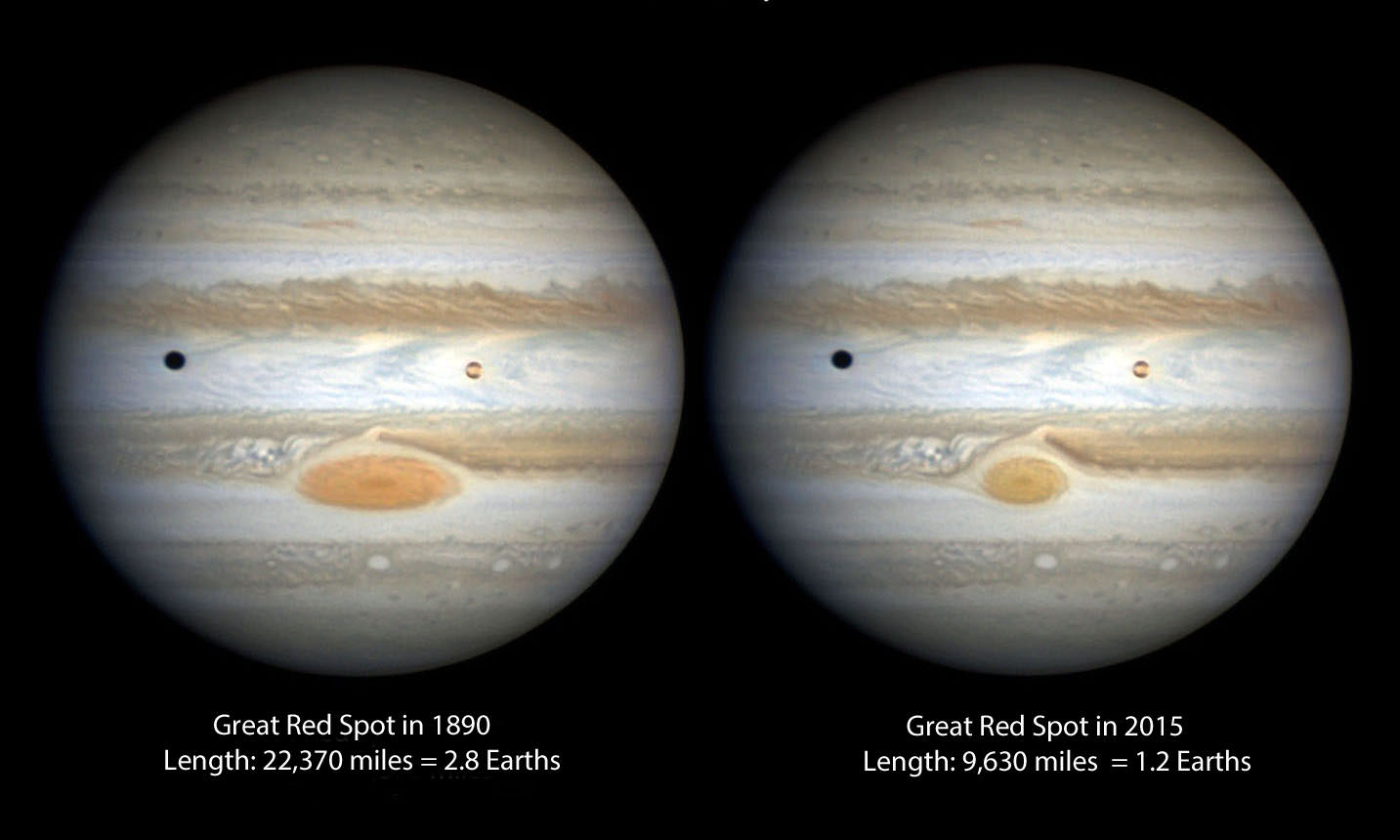
Maybe it’s too soon for a pity party, but the profound changes in the size and prominence of Jupiter’s Great Red Spot (GRS) in the past 100 years has me worried. After Saturn’s rings, Jupiter’s big bloody eye is one of astronomy’s most iconic sights.
This titanic hurricane-like storm has charmed earthlings since Giovanni Cassini first spotted it in the mid-1600s. Will our grandchildren turn their telescopes to Jove only to see a pale pink oval like so many others rolling around the planet’s South Tropical Zone?
Maybe.
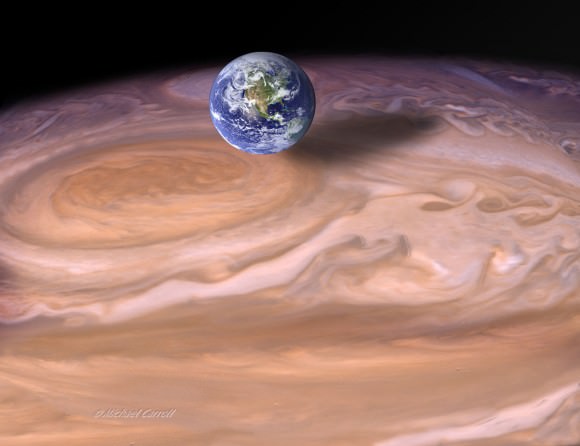
An inspired image prompted this sad train of thought. UK astrophotographer Damian Peach came up with an ideal way to depict how the GRS would look to us now if it we could see it as it was in 1890, 125 years ago. Those were the glory days for the “Eye of Jupiter” as Cassini was fond of calling it. With a diameter of 22,370 miles (36,000 km), the GRS spanned nearly three Earths wide. What a sight it must have been in nearly any telescope.
Peach compared measurements of the Spot in black and white photos taken at Lick Observatory in California in 1890-91 with a photo he took on April 13 this year. He then manipulated his April 13 data using the Lick photos and WINJUPOS (Jupiter feature measuring program) to carefully match the storm to its dimensions and appearance 125 years ago. Voila! Now we have a good idea of what we missed by being born too late.
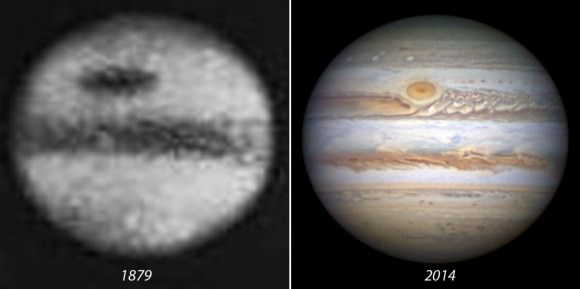
“A century ago, it truly was deserving of its name!” wrote Peach.

The shrinking of the Great Red Spot isn’t breaking news. You read about it here in Universe Today more than year ago. Before that, Jupiter observers had grumbled for years that the once-easy feature had become anemic and not nearly as obvious as once remembered. Astronomers have been following its downsizing since the 1930s.
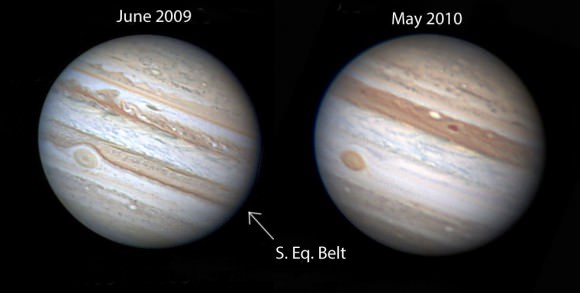
That doesn’t mean it’s necessarily going away, though if it did — at least temporarily — it wouldn’t be the first time. The Spot vanished in the 1680s only to reappear in 1708. Like clouds and weather fronts that keeps things lively on Earth, Jupiter’s atmosphere constantly cooks up new surprises. The entire South Equatorial Belt, one of Jupiter’s two most prominent “stripes”, has taken a leave of absence at least 17 times since the invention of the telescope, the last in 2010.
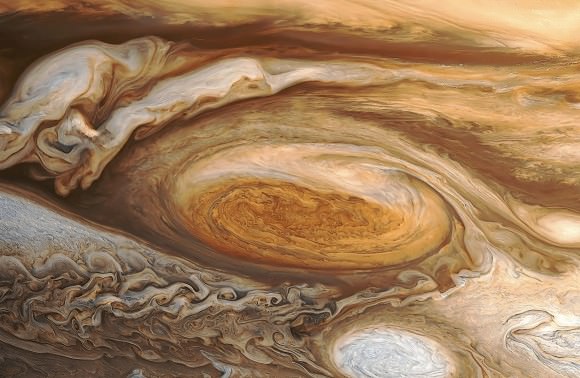
Perhaps we should turn the question around? How has the Red Spot managed to last this long? Hurricanes on Earth have lifetimes measured in days, while this whirling vortex has been around for hundreds of years. Any number of things should have killed it: loss of energy through radiation of heat to outer space, or energy-sapping turbulence from nearby jet streams. But the Eye persists. So what keeps it alive? Astronomers think the storm might gain energy by devouring smaller vortices, those small white dots and ovals you see in high resolution photos of the planet. Vertical winds that transport hot and cold gases in and out of the Spot may also restore its vigor.
Just in case it disappears unexpectedly, take one last look this observing season. Jupiter’s currently getting lower in the western sky as it approaches Venus for its grand conjunction on June 30. Below are times (Central Daylight or CDT) when it crosses or transits the planet’s central meridian. The GRS will be easiest to see for a 2-hour interval starting an hour before the times shown. It’s located in the planet’s southern hemisphere just south of the prominent South Equatorial Belt. Add an hour for Eastern time; subtract one hour for Mountain and two hours for Pacific. A complete list of transit times can be found HERE.
* June 13 at 8:58 p.m.
* June 18 at 12:16 a.m.
* June 18 at 8:08 p.m.
* June 20 at 9:47 p.m.
* June 22 at 11:26 p.m.
* June 25 at 8:57 p.m.
* June 27 at 10:36 p.m.
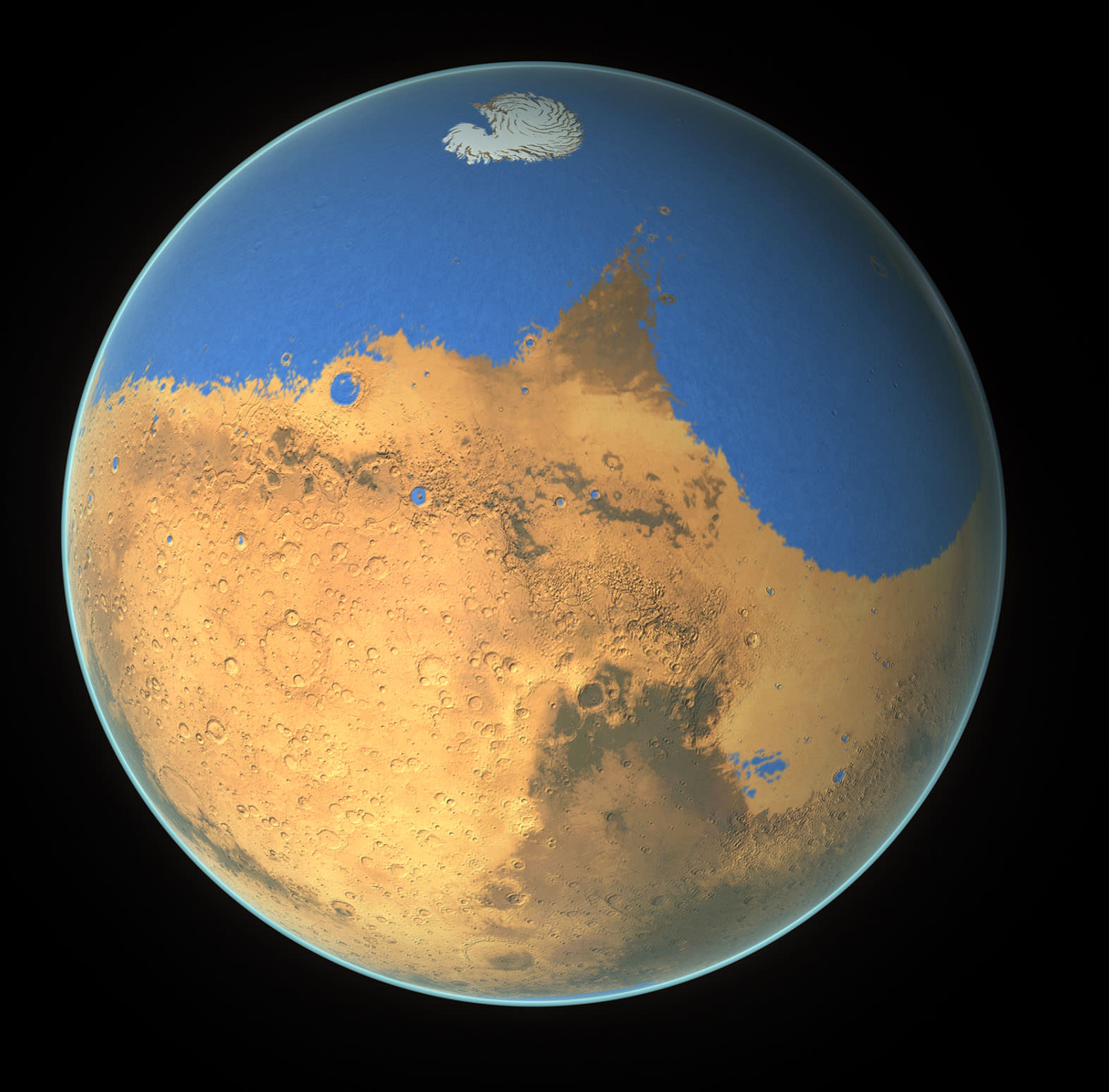
It’s hard to believe it now looking at Mars’ dusty, dessicated landscape that it once possessed a vast ocean. A recent NASA study of the Red Planet using the world’s most powerful infrared telescopes clearly indicate a planet that sustained a body of water larger than the Earth’s Arctic Ocean.
If spread evenly across the Martian globe, it would have covered the entire surface to a depth of about 450 feet (137 meters). More likely, the water pooled into the low-lying plains that cover much of Mars’ northern hemisphere. In some places, it would have been nearly a mile (1.6 km) deep.
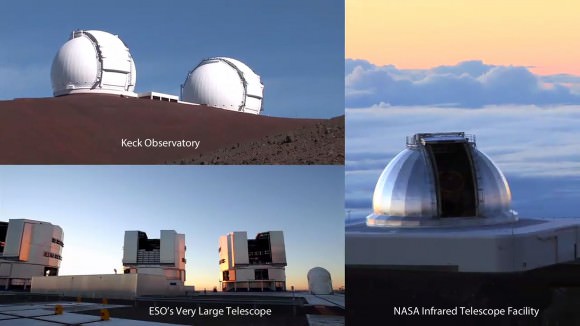
Now here’s the good part. Before taking flight molecule-by-molecule into space, waves lapped the desert shores for more than 1.5 billion years – longer than the time life needed to develop on Earth. By implication, life had enough time to get kickstarted on Mars, too.
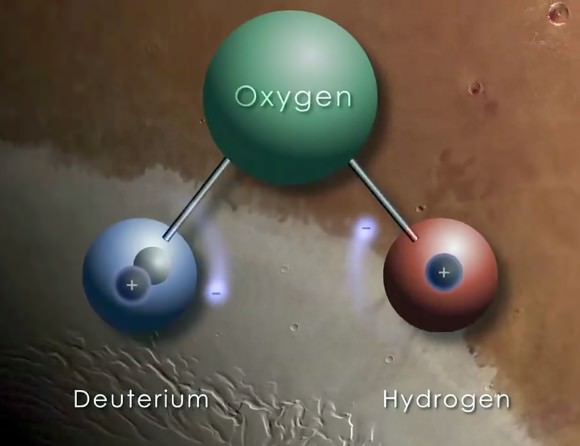
Using the three most powerful infrared telescopes on Earth – the W. M. Keck Observatory in Hawaii, the ESO’s Very Large Telescope and NASA’s Infrared Telescope Facility – scientists at NASA’s Goddard Space Flight Center studied water molecules in the Martian atmosphere. The maps they created show the distribution and amount of two types of water – the normal H2O version we use in our coffee and HDO or heavy water, rare on Earth but not so much on Mars as it turns out.
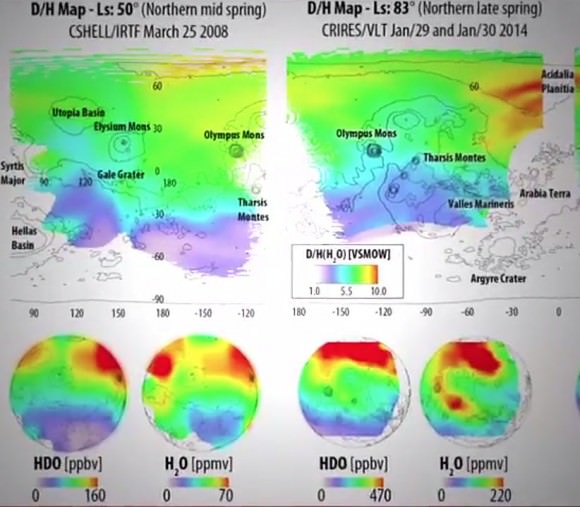
In heavy water, one of the hydrogen atoms contains a neutron in addition to its lone proton, forming an isotope of hydrogen called deuterium. Because deuterium is more massive than regular hydrogen, heavy water really is heavier than normal water just as its name implies. The new “water maps” showed how the ratio of normal to heavy water varied across the planet according to location and season. Remarkably, the new data show the polar caps, where much of Mars’ current-day water is concentrated, are highly enriched in deuterium.
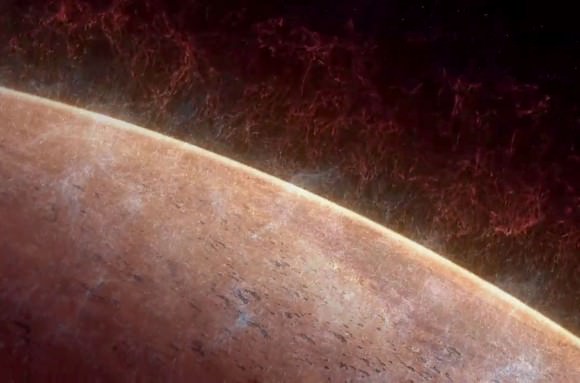
On Earth, the ratio of deuterium to normal hydrogen in water is 1 to 3,200, but at the Mars polar caps it’s 1 to 400. Normal, lighter hydrogen is slowly lost to space once a small planet has lost its protective atmosphere envelope, concentrating the heavier form of hydrogen. Once scientists knew the deuterium to normal hydrogen ratio, they could directly determine how much water Mars must have had when it was young. The answer is A LOT!
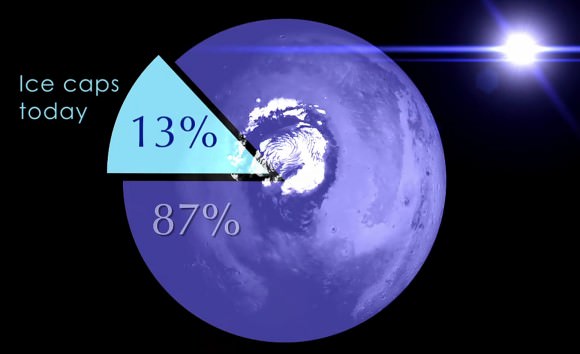
Only 13% of the original water remains on the planet, locked up primarily in the polar regions, while 87% of the original ocean has been lost to space. The most likely place for the ocean would have been the northern plains, a vast, low-elevation region ideal for cupping huge quantities of water. Mars would have been a much more earth-like planet back then with a thicker atmosphere, providing the necessary pressure, and warmer climate to sustain the ocean below.
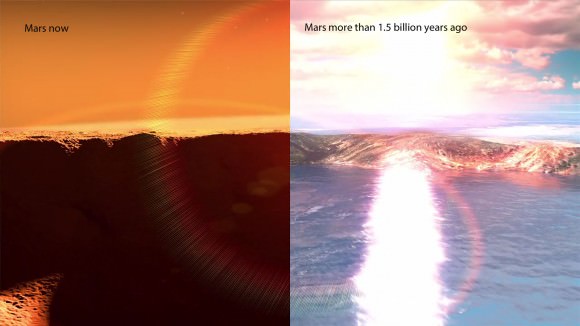
What’s most exciting about the findings is that Mars would have stayed wet much longer than originally thought. We know from measurements made by the Curiosity Rover that water flowed on the planet for 1.5 billion years after its formation. But the new study shows that the Mars sloshed with the stuff much longer. Given that the first evidence for life on Earth goes back to 3.5 billion years ago – just a billion years after the planet’s formation – Mars may have had time enough for the evolution of life.
So while we might bemoan the loss of so wonderful a thing as an ocean, we’re left with the tantalizing possibility that it was around long enough to give rise to that most precious of the universe’s creations – life.
To quote Charles Darwin: “… from so simple a beginning endless forms most beautiful and most wonderful have been, and are being, evolved.
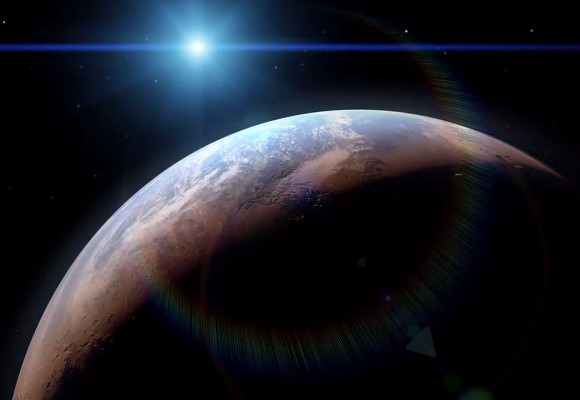

A storm is brewing, a battle of words and a war of the worlds. The Earth is not at risk. It is mostly a civil dispute, but it has the potential to influence the path of careers. In 2014, a Harvard led debate was undertaken on the question: Is Pluto a planet. The impact of the definition of planet and everything else is far reaching – to the ends of the Universe.
It could mean a count of trillions of planets in our galaxy alone or it means leaving the planet Pluto out of the count – designation, just a dwarf planet. This is a question of how to classify non-stellar objects. What is a planet, asteroid, comet, planetoid or dwarf planet? Does our Solar System have 8 planets or some other number? Even the count of planets in our Milky Way galaxy is at stake.
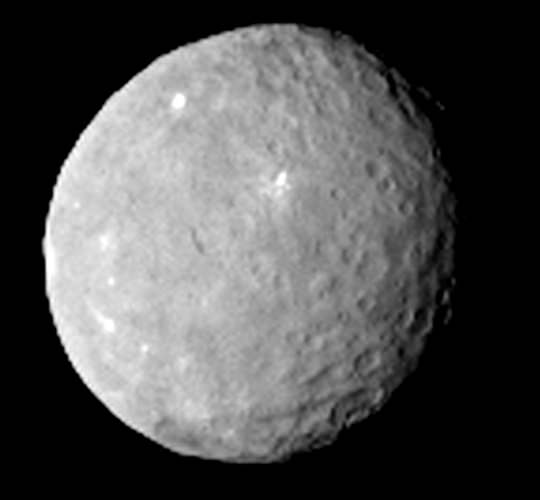
Not to dwell on the Harvard debate, let it be known that if given their way, the debates outcome would reset the Solar System to nine planets. For over eight years, the solar system has had eight planets. During the period 1807 to 1845, our Solar System had eleven planets. Neptune was discovered in 1846 and astronomers began to discover many more asteroids. They were eliminated from the club. This is very similar to what is now happening to Pluto-like objects – Plutoids. So from 1846 to 1930, there were 8 planets – the ones as defined today.
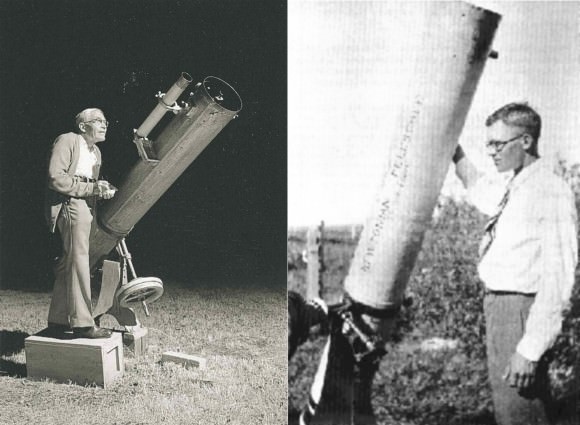
In 1930, a Kansas farm boy, Clyde Tombaugh, hired by Lowell Observatory discovered Pluto and for 76 years there were 9 planets. In the year 2006, the International Astronomical Union (IAU) took up a debate using a “democratic process” to accept a new definition of planet, define a new type – dwarf planet and then set everything else as “Small Bodies.” If your head is spinning with planets, you are not alone.

Two NASA missions were launched immediately before and after the IAU announcement took affect. The Dawn mission suddenly was to be launched to an asteroid and a dwarf planet and the New Horizons had rather embarked on a nine year journey to a planet belittled to a dwarf planet – Pluto. Principal Investigator, Dr. Alan Stern was upset. Furthermore, from the discoveries of the Kuiper mission and other discoveries, we now know that there are hundreds of billions of planets in our Milky Way galaxy; possibly trillions. The present definition excludes hundreds of billions of bodies from planethood status.

There are two main camps with de facto leaders. One camp has Dr. Mike Brown of Caltech and the other, Dr. Stern of the Southwest Research Institute (SWRI) as leading figures. A primary focus of Dr. Brown’s research is the study of trans-Neptunian objects while Dr. Sterns’s activities are many but specifically, the New Horizons mission which is 6 months away from its flyby of Pluto. Consider first the IAU Resolution 5A that its members approved:
(1) A “planet” is a celestial body that (a) is in orbit around the Sun, (b) has sufficient mass for its self-gravity to overcome rigid body forces so that it assumes a hydrostatic equilibrium (nearly round) shape, and (c) has cleared the neighborhood around its orbit.
(2) A “dwarf planet” is a celestial body that (a) is in orbit around the Sun, (b) has sufficient mass for its self-gravity to overcome rigid body forces so that it assumes a hydrostatic equilibrium (nearly round) shape2, (c) has not cleared the neighbourhood around its orbit, and (d) is not a satellite.
(3) All other objects, except satellites, orbiting the Sun shall be referred to collectively as “Small Solar System Bodies”.
This is our starting point – planet, dwarf planet, everything else. Consider “everything else”. This broad category includes meteoroids, asteroids, comets and planetesimals. Perhaps other small body types will arise as we look more closely at the Universe. Within the category, there is now a question of what is an asteroid and what is a comet. NASA’s flybys of comets and now ESA’s Rosetta at 67P/Churyumov–Gerasimenko are making the delineation between the two types difficult. The difference between a meteoroid and an asteroid is simply defined as less than or greater than one meter in size, respectively. So the Chelyabinsk event absolutely involved a small asteroid – about 20 meters in diameter. Planetesimals are small bodies in a solar nebula that are the building blocks of planets but they could lead to the creation of all the other types of small bodies.
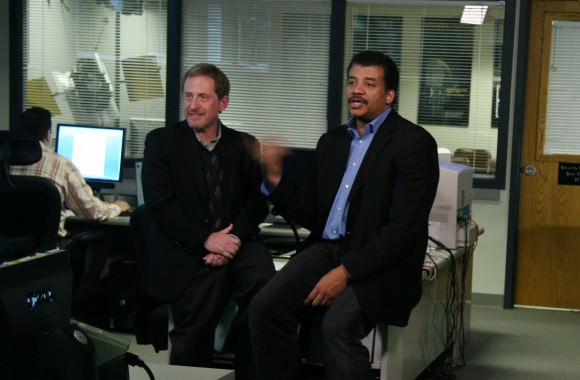
Putting aside the question of “Small Bodies” and its sub-classes, what should be the definition of planet and dwarf planet? These are the two terms that demoted Pluto and raised Ceres to dwarf planet. It is also interesting to note how Resolution 5A is meant exclusively for our Solar System. In 2006, there were not thousands of exo-planets but just a few dozen extreme cases but nevertheless, the IAU did not choose to extend the definition to “stars” but rather just in reference to our pretty well known star, the Sun.
Recall Tim Allen’s movie, “The Santa Clause”. Clauses can cause a heap of trouble. The IAU has such a clause – Clause C which has caused much of the present controversy around the definition of planets. Clause (c) of Resolution 5A: “has cleared the neighborhood around its orbit.” This is the Pluto killer-clause which demoted it to dwarf planet status and reduced the number of planets in our solar system to eight. In a sense, the IAU chose to cauterize a wound, a weakness in the definitions, that if left unchanged, would have led to who knows how many planets in our Solar System.
The question of what is Pluto is open for public discussion so armed with enough knowledge to be dangerous, the following is my proposed alternative to the IAU’s that are arguably an improvement. The present challenge to Pluto’s status lies in the Kuiper Belt and Oort Cloud. Such belts or clouds are probably not uncommon throughout the galaxy. Plutoids are the 500 lb gorilla in the room.
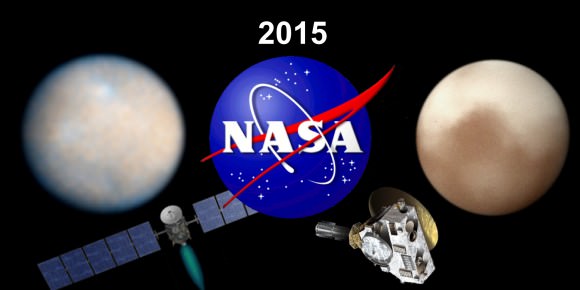
This year, as touted by the likes of Planetary Society, Universe Today and elsewhere, is the year of the dwarf planet. How remarkable and surprising will the study of Ceres, Pluto and Charon by NASA spacecraft be? There is a strong possibility that after the celestial dust clears and data analysis is published, the IAU will take on the challenge again to better define what is a planet and everything else. It is impossible to imagine that the definitions can remain unchanged for long. Even now, there is sufficient information to independently assess the definitions and weigh in on the approaching debate. Anyone or any group – from grade schools to astronomical societies – can take on the challenge.
To encourage a debate and educate the public on the incredible universe that space probes and advanced telescopes are revealing, what follows is one proposed solution to what is a planet and everything else.
planet: is a celestial body that a) has sufficient mass for its self-gravity to overcome rigid body forces so that it assumes a hydrostatic equilibrium – nearly round shape, b) has a differentiated interior as a result of its formation c) has insufficient mass to fuse hydrogen in its core, d) does not match the definition of a moon.
minor planet: is a planet with a mass less than one Pluto mass and does not match the definition of a moon.
inter-Stellar (minor) planet: is a (minor) planet that is not gravitationally bound to a stellar object.
binary (minor) planet: is a celestial body that is orbiting another (minor) planet for which the system’s barycenter resides above the surface of both bodies.
These definitions solve some hairy dilemmas. For one, planets orbit around the majority of most stars in the Universe, not just the Sun as Resolution 5A was only intended. Planets can also exist gravitationally not bound to a star – the result of it own molecular cloud collapse without a star or expulsion from a stellar system. One could specify gravitational expulsion however, it is possible that explosive events occur that cause the disintegration of a star and its binding gravity or creates such an impulse that a planet is thrusted out of a stellar system. Having an atmosphere certainly doesn’t work. Astronomers are already anticipating Mars or Earth-sized objects deep in the Oort cloud that could have no atmosphere – frozen out and also despite their size, not be able to “clear their neighborhood.”
The need to create a lower-end limit to what is a planet reached a near fever pitch with the discovery of a Trans-Nepturnian Object (TNO) in 2005 that is bigger than Pluto – Eris. Dr. Michael Brown of Caltech and his team led in the discovery of bright large KBOs. There was not just Eris but many of nearly the same size as Pluto. So without clause (c), one would be left with a definition for planet that could allow the count of planets in our Solar System to rise into the hundreds maybe even thousands. This would become a rather unmanageable problem; the number of planets rising year after year and never settled and with no means to make reasonable comparisons between planetary systems throughout our galaxy and even the Universe.
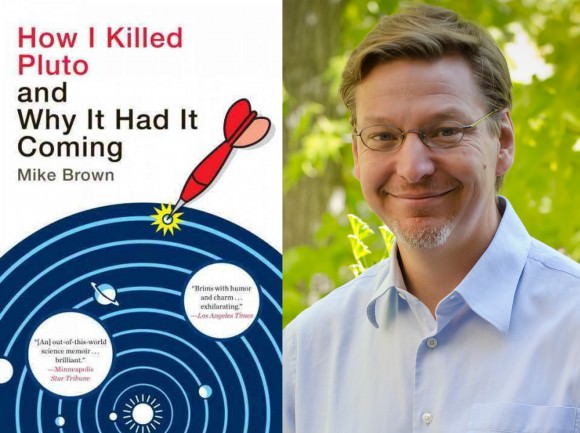
Two more celestial body types follow that are proposed to round out the set.
moon: is a celestial body that a) orbits a (minor) planet and b) for which the barycenter of its orbit is below the surface of its parent (minor) planet.
This creates the possibility of a planet-moon system such that its barycenter is above the surface of the larger body. Pluto and Charon are the most prominent case in our Solar System. In such cases, if one body meets the criteria of a (minor)planet, then the other body can also be assessed to determine if it is also a (minor) planet and the pair as binary (minor) planets. If the primary body was a minor planet, it is possible that the barycenter could be above its surface but the secondary body does not meet all the criteria of a minor planet, specifically “differentiated interior”.
The definition of moon is compounded by the existence of, for example, asteroids with moons. For such objects, the smaller object is defined as a satellite.
Satellite: is a celestial body that a) orbits another celestial body, b) whose parent body is not a (minor) planet.
Another permissible term is moonlet which could be used to describe both very small moons such as those found in the Jovian and Saturn systems or a small body orbiting an asteroid or comet. Moonlet could replace satellite.
The discriminator between planet and moon is not mass but simply whether the celestial body orbits a (minor) planet and the barycenter resides inside the larger body. The definition of moon excludes the possibility of a planet orbiting another planet except in the special case of binary (minor) planet.
Defining a lower size limit to “Planet” is necessary to compare stellar systems and classify. A limit based on the body’s average surface pressure and temperature or the surface gravity could define a limit. While they could, they are not practical because of the extremes and diverse combinations of conditions. Strange objects would fall through the cracks.
Removing clause (c) – “has cleared the neighborhood around its orbit” – will avoid a future conflict such as a very low mass star with a plutoid-sized object or smaller, in a close orbit that has cleared its neighborhood.
Additionally, choosing to declare that Pluto becomes the “standard weight” that differentiates minor planet from planet sets a precedent. In an era in which computers measure and tally the state of our existence, setting this limit to include Pluto and return it as the ninth planet of our Solar System, is, in a small but significant way, a re-declaration of our humanity. Soon we will be challenged by artificial intelligence greater than ours; we are already have. Where will we stand our ground?
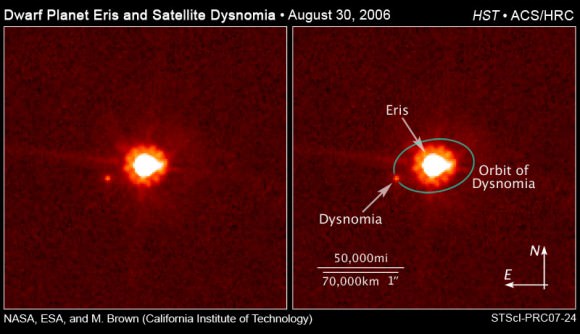
The consequences of this proposed set of definitions, makes Ceres a minor planet and no longer an asteroid. Many trans-Neptunian objects discovered in this century become minor planets. Of the known TNOs only Pluto and Eris meets the criteria of planet.The dwarf planet Eris would become the tenth planet. Makemake, Sedna, Quaoar, Orcus, Haumea would be minor planets. By keeping Pluto a planet and defining it as the standard bearer, only one new planet must be declared. Surely, more will be found, very distant, in odd elliptical and tilted orbits. The count of planets in our solar system could rise by 10, 20 maybe 50 and perhaps this would make the definition untenable but maybe not. So be it. New Horizons will fly by a dwarf planet in July but this should mark the beginning of the end of the present set of definitions.
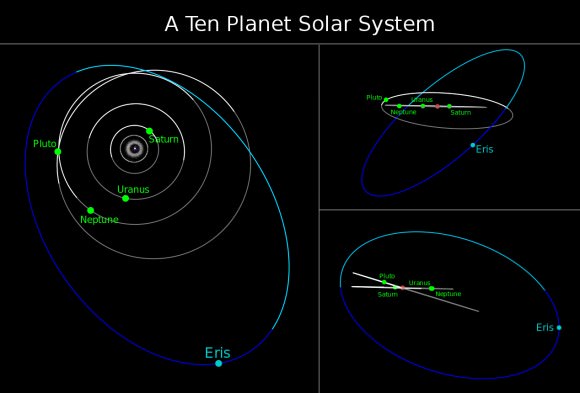
This set of definitions defines a set of celestial bodies that consistently covers the spectrum of known bodies. There is the potential of exotic celestial objects that are spawned from cataclysmic events or from the unique conditions during the early epochs of the Universe or from remnants of old or dying stellar objects. Their discovery will likely trigger new or revised definitions but these definitions are a good working set for the time being. Ultimately, it is the decision of the IAU but the sharing of knowledge and the democratic processes that we cherish permits anyone to question and evaluate such definitions or proclamations.To all that share an interest in Pluto as or as not a planet raise your hand and be heard.
A video from 2014 by Kurz Gesagt describing the Pluto-Charon system. Is this a binary planet system or one of the “dwarf” variety?
Further Reading
Learn All About Pluto, The Most Famous Dwarf Planet, E. Howell, Universe Today, 1/17/2015
A synopsis of Pluto facts and figures at Universe Today, compendium of pages on Pluto
What is the Kuiper Belt?, video, Universe Today, 12/30/2013, Fraser Cain asks Mike Brown to explain the Kuiper Belt
Is The Moon A Planet?, E. Howell, Universe Today, 1/27/2015
It Looks Like These Are All the Bright Kuiper Belt Objects We’ll Ever Find, Universe Today, 1/12/2015
2015, NASA’s Year of the Dwarf Planet, Universe Today, 12/14/2014
A Serendipitous All Sky Survey For Bright Objects In The Outer Solar System, Cornell University Library, 1/5/2015
Ten Years of Eris, at Mike Brown’s Planets, 1/5/2015
My condolences to the friends and family of Tammy Plotner, the first regular contributing writer to Universe Today. Can’t we all relate to what drew Tammy to write about the Universe? She wrote outstanding articles for U.T.

A quarter of a century has passed since NASA’s Voyager 1 spacecraft snapped the iconic image of Earth known as the “Pale Blue Dot” that shows all of humanity as merely a tiny point of light.
The outward bound Voyager 1 space probe took the ‘pale blue dot’ image of Earth 25 years ago on Valentine’s Day, on Feb. 14, 1990 when it looked back from its unique perch beyond the orbit of Neptune to capture the first ever “portrait” of the solar system from its outer realms.
Voyager 1 was 4 billion miles from Earth, 40 astronomical units (AU) from the sun and about 32 degrees above the ecliptic at that moment.
The idea for the images came from the world famous astronomer Carl Sagan, who was a member of the Voyager imaging team at the time.
He head the idea of pointing the spacecraft back toward its home for a last look as a way to inspire humanity. And to do so before the imaging system was shut down permanently thereafter to repurpose the computer controlling it, save on energy consumption and extend the probes lifetime, because it was so far away from any celestial objects.
Sagan later published a well known and regarded book in 1994 titled “Pale Blue Dot,” that refers to the image of Earth in Voyagers series.
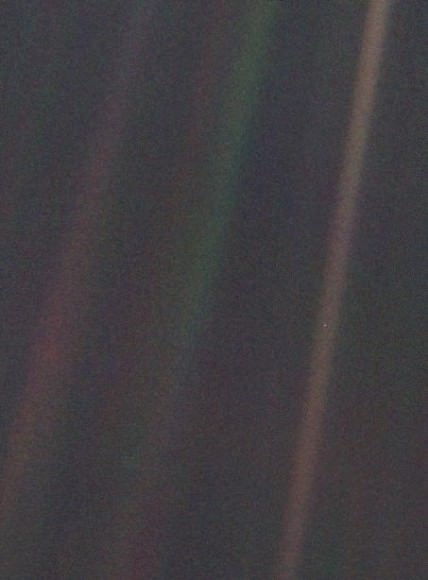
“Twenty-five years ago, Voyager 1 looked back toward Earth and saw a ‘pale blue dot,’ ” an image that continues to inspire wonderment about the spot we call home,” said Ed Stone, project scientist for the Voyager mission, based at the California Institute of Technology, Pasadena, in a statement.
Six of the Solar System’s nine known planets at the time were imaged, including Venus, Earth, Jupiter, and Saturn, Uranus, Neptune. The other three didn’t make it in. Mercury was too close to the sun, Mars had too little sunlight and little Pluto was too dim.
Voyager snapped a series of images with its wide angle and narrow angle cameras. Altogether 60 images from the wide angle camera were compiled into the first “solar system mosaic.”
Voyager 1 was launched in 1977 from Cape Canaveral Air Force Station in Florida as part of a twin probe series with Voyager 2. They successfully conducted up close flyby observations of the gas giant outer planets including Jupiter, Saturn, Uranus and Neptune in the 1970s and 1980s.
Both probes still operate today as part of the Voyager Interstellar Mission.
“After taking these images in 1990, we began our interstellar mission. We had no idea how long the spacecraft would last,” Stone said.
Hurtling along at a distance of 130 astronomical units from the sun, Voyager 1 is the farthest human-made object from Earth.

Voyager 1 still operates today as the first human made instrument to reach interstellar space and continues to forge new frontiers outwards to the unexplored cosmos where no human or robotic emissary as gone before.
Here’s what Sagan wrote in his “Pale Blue Dot” book:
“That’s here. That’s home. That’s us. On it everyone you love, everyone you know, everyone you ever heard of, every human being who ever was, lived out their lives. … There is perhaps no better demonstration of the folly of human conceits than this distant image of our tiny world.”
Stay tuned here for Ken’s continuing Earth and planetary science and human spaceflight news.
The current most-used Solar System mnemonic for remembering the planets and their order from the Sun is “My Very Educated Mother Just Served Us Noodles.” But, it’s the “Year of the Dwarf Planet” and some folks are hoping all the dwarfs of our Solar System will get a little more respect and possibly be considered “real” planets.
A group of science writers from The New York Times are among those who are “rooting for the dwarf planets to be considered actual planets.” But if that were to happen, one issue would be that we’d need a new memorization mnemonic (I know… this is a a horrible dilemma.)
It wouldn’t be just adding P for Pluto (and reverting back to the old “My Very Excellent Mother Just Served Us Nine Pizzas) — you’d have to add a C in the middle for Ceres, along with E for Eris, H for Haumea and M for Makemake at the end.
So, Universe Today readers, let’s help The New York Times find some new mnemonics.
Here would be the order:
Mercury
Venus
Earth
Mars
Ceres
Jupiter
Saturn
Uranus
Neptune
Pluto
Haumea
Makemake
Eris
And while we’re at it, we’ll take suggestions for a new (family friendly, please) mnemonic for the current 8 planets we have, something without Mothers and Noodles, perhaps. Planet hunter Mike Brown from Caltech (one of the folks responsible for all this planet arguing) has suggested “Mean Very Evil Men Just Shortened Up Nature.”
Put your ideas in the comments below.
The final chapter in the saga of a wayward Mars lander was finally revealed today, as an international team released images showing the Beagle-2 lander’s final resting place on Mars.
Flashback to Christmas Day, 2003. While most folks gathered ‘round the tree and opened presents, the UK and European Space Agency awaited a gift from space. The Beagle-2 Mars lander had been released from the European Space Agency’s Mars Express orbiter six days prior, and was coasting towards a perilous landing in Isidis Planitia and was set to phone home.
All was going according to plan, and then… silence.
It’s the worst part of any mission, waiting for a lander to call back and say that it’s safe and sound on the surface of another world. As the hours turned into days, anxious engineers used NASA’s Mars Odyssey spacecraft and the Lovell Telescope at Jodrell Bank to listen for the signal.
Beagle-2 was declared lost a few weeks later on February 6th, 2004.
But now, there’s a final twist to the tale to tell.
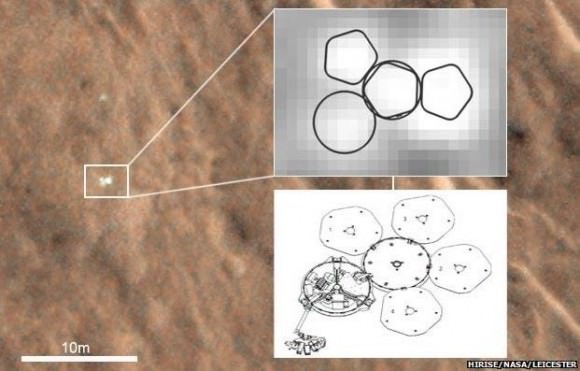
The UK Space Agency, working with ESA and NASA announced today that debris from the landing site had been identified and that indicates — contrary to suspicions — that Beagle-2 did indeed make it to the surface of the Red Planet intact. New images from the Mars Reconnaissance Orbiter released today suggest that not only did Beagle-2 land, but that its airbags did indeed deploy properly and that the dish-shaped 1-meter in diameter spacecraft partially unfolded pocket-watch style after it had bounced to a stop.
“We are very happy to learn that Beagle 2 touched down on Mars,” said ESA’s Director of Science and Robotic Exploration in a recent press release. “The dedication of the various teams in studying high-resolution images in order to find the lander is inspiring.”
So, what went wrong with Beagle-2?
At this point, no further speculation as to what caused the lander to fall silent has been forthcoming, but today’s revelation is sure to rewrite the final saga of Beagle-2.
“Not knowing what happened to Beagle-2 remained a nagging worry,” said ESA’s Mars Express project manager Rudolf Schmidt. “Understanding now that Beagle-2 made it all the way down to the surface is excellent news.”
Speculation swirled across the internet earlier this week as the UK Space Agency and ESA suggested that new information as to the fate of Beagle-2 was forthcoming, over 11 years after the incident. Back in 2004, it was suggested that Beagle-2 had encountered higher levels of dust in the Martian atmosphere than expected, and that this in turn resulted in a failure of the spacecraft’s parachutes. Presumably, the lander then failed to slow down sufficiently and crashed on the surface of Mars, the latest victim of the Great Galactic Ghoul who seems to love dining on human-built spacecraft bound for the Red Planet.
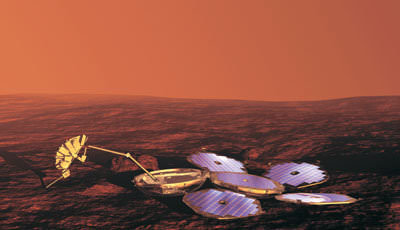
The loss of Beagle-2 wasn’t only a blow to the UK and ESA, but to its principal investigator Colin Pillinger as well. Pillinger was involved in the search for Beagle-2 in later years, and also played a part in the Rosetta mission to Comet 67P/Churyumov-Gerasimenko as well. Unfortunately, Pillinger passed away in May of last year from a brain hemorrhage. A portion of the western rim of Endeavour Crater currently being explored by Opportunity was named Pillinger Point in his honor.
Today’s announcement has triggered a wave of congratulations that the 11-year mystery has been solved. There have even been calls on Twitter and social media to rename the Beagle-2 site Pillinger Station.
“The history of of space exploration is marked by both success and failure,” Said Dr. David Parker, the Chief Executive of the UK Space Agency in a recent press release. “This finding makes the case that Beagle-2 was more of a success than we previously knew and undoubtedly an important step in Europe’s continuing exploration of Mars.”
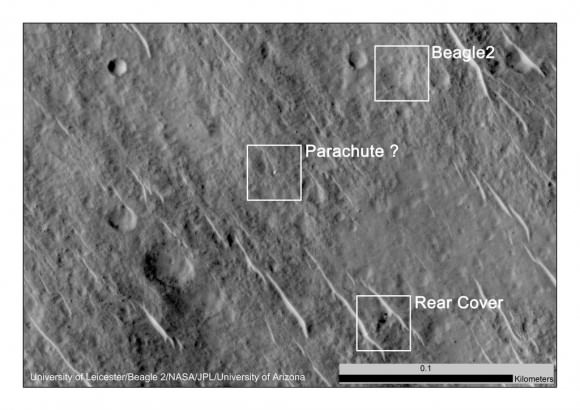
Beagle-2 is about 2 metres across unfurled, and came to rest within 5 kilometres of its target location.
There have been false announcements of the discovery of Beagle-2 before. Back in late 2005, a claim was made that the lander had been spotted by Mars Global Surveyor, though later searches came to naught.
“I can imagine the sense of closure that the Beagle-2 team must feel,” Said JPL’s MRO project scientist Richard Zurek in a recent press release. “MRO has helped find safe landing sites on Mars for the Curiosity and Phoenix missions and has searched for missing craft to learn what may have gone wrong. It’s an extremely difficult task.”
MRO entered orbit in March 2006 and carries a 0.5 metre in diameter HiRISE camera capable of resolving objects just 0.3 metres across on the surface of Mars. The European Space Agency’s Mars Express orbiter that carried Beagle 2 is also still in operation, along with NASA’s aging Mars Odyssey spacecraft. These were joined in orbit by MAVEN and India’s Mars Orbiter just last year.
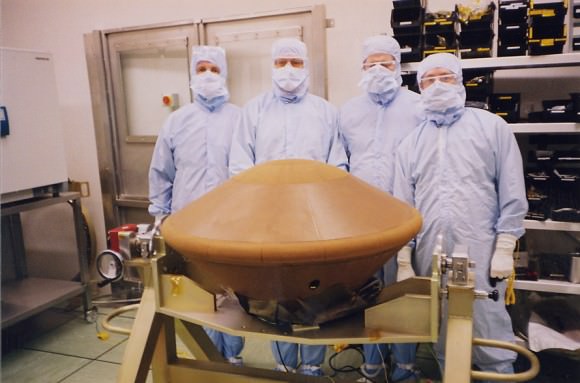
Of course, getting to Mars is tough, and landing is even harder. Mars has just enough atmosphere that you have to deal with it, but it’s so tenuous – 0.6% the surface pressure of Earth’s atmosphere at sea level – That it doesn’t provide a whole lot of usable drag.
To date, only NASA had successfully landed on Mars, and done it seven times – only the Mars Polar Lander failed back in 1999. The Russians fared much worse, with their most successful lander being Mars 3, which sent back only one blurry image before falling silent.
ESA and the Russian Federal Space Agency hope to amend that with the launch of the ExoMars mission next year, slated to land on Mars in 2018.
I remember waiting with millions of other space fans for word back from Beagle 2 on Christmas Day 2003. Think back to what your internet connection was like over 11 years ago, in an era before smart phones, Twitter and Facebook. We’d just come off of the spectacular 2003 Mars opposition season, which provided the orbital geometry ideal for launching a mission to the Red Planet. This window only comes around once every 26 months.
Though Beagle 2 was a stationary lander akin to the Viking and Mars Phoenix missions, it had a robotic arm and a clever battery of experiments, including ones designed to search for life. The signal it was supposed to use to call home was designed by the UK pop rock band Blur, a jingle that never came.
Alas, we’ll have to wait to see what the alien plains around Isidis Planitia actually look like, just 13 degrees north of the Martian equator. But hey, a lingering mystery of the modern age of planetary exploration was solved this week.
Still, we’re now left with a new dilemma. Does this mean we’ll have to write a sequel to our science fiction short story The Hunt for Beagle?
-Read free original science fiction from Dave Dickinson every Friday, including ongoing chapters from The Hunt for Beagle.
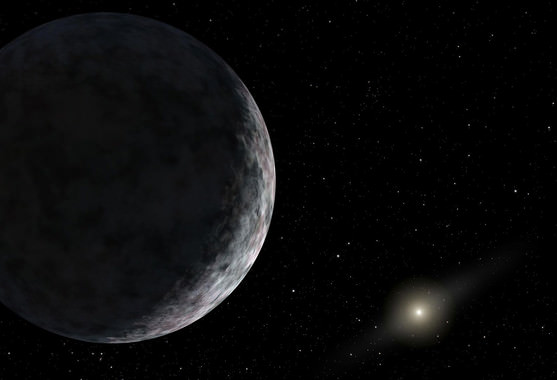
Could there be another Pluto-like object out in the far reaches of the Solar System? How about two or more?
Earlier this week, we discussed a recent paper from planet-hunter Mike Brown, who said that while there aren’t likely to be any bright, easy-to-find objects, there could be dark ones “lurking far away.” Now, a group of astronomers from the UK and Spain maintain at least two planets must exist beyond Neptune and Pluto in order to explain the orbital behavior of objects that are even farther out, called extreme trans-Neptunian objects (ETNO).

We do know that Pluto shares its region Solar System with more than 1500 other tiny, icy worlds along with likely countless smaller and darker ones that have not yet been detected.
In two new paper published this week, scientists at the Complutense University of Madrid and the University of Cambridge noted that the most accepted theory of trans-Neptunian objects is that they should orbit at a distance of about 150 AU, be in an orbital plane – or inclination – similar to the planets in our Solar System, and they should be randomly distributed.
But that differs from what is actually observed. What astronomers see are groupings of objects with widely disperse distances (between 150 AU and 525 AU) and orbital inclinations that vary between 0 to 20 degrees.
“This excess of objects with unexpected orbital parameters makes us believe that some invisible forces are altering the distribution of the orbital elements of the ETNO,” said Carlos de la Fuente Marcos, scientist at UCM and co-author of the study, “ and we consider that the most probable explanation is that other unknown planets exist beyond Neptune and Pluto.”
He added that the exact number is uncertain, but given the limited data that is available, their calculations suggest “there are at least two planets, and probably more, within the confines of our solar system.”
In their studies, the team analyzed the effects of what is called the ‘Kozai mechanism,’ which is related to the gravitational perturbation that a large body exerts on the orbit of another much smaller and further away object. They looked at how the highly eccentric comet 96P/Machholz1 is influenced by Jupiter (it will come near the orbit of Mercury in 2017, but it travels as much as 6 AU at aphelion) and it may “provide the key to explain the puzzling clustering of orbits around argument of perihelion close to 0° recently found for the population of ETNOs,” the team wrote in one of their papers.

They also looked at the dwarf planet discovered last year called 2012 VP113 in the Oort cloud (its closest approach to the Sun is about 80 astronomical units) and how some researchers say it appears its orbit might be influenced by the possible presence of a dark and icy super-Earth, up to ten times larger than our planet.
“This Sedna-like object has the most distant perihelion of any known minor planet and the value of its argument of perihelion is close to 0°,” the team writes in their second paper. “This property appears to be shared by almost all known asteroids with semimajor axis greater than 150 au and perihelion greater than 30 au (the extreme trans-Neptunian objects or ETNOs), and this fact has been interpreted as evidence for the existence of a super-Earth at 250 au. In this scenario, a population of stable asteroids may be shepherded by a distant, undiscovered planet larger than the Earth that keeps the value of their argument of perihelion librating around 0° as a result of the Kozai mechanism.”
Of course, the theory put forth in two papers published by the team goes against the predictions of current models on the formation of the Solar System, which state that there are no other planets moving in circular orbits beyond Neptune.
But the team pointed to the recent discovery of a planet-forming disk around the star HL Tauri that lies more than 100 astronomical units from the star. HL Tauri is more massive and younger than our Sun and the discovery suggests that planets can form several hundred astronomical units away from the center of the system.
The team based their analysis by studying 13 different objects, so what is needed is more observations of the outer regions of our Solar System to determine what might be hiding out there.
Further reading:
Carlos de la Fuente Marcos, Raúl de la Fuente Marcos, Sverre J. Aarseth. “Flipping minor bodies: what comet 96P/Machholz 1 can tell us about the orbital evolution of extreme trans-Neptunian objects and the production of near-Earth objects on retrograde orbits”. Monthly Notices of the Royal Astronomical Society 446(2):1867-1873, 2015.
C. de la Fuente Marcos, R. de la Fuente Marcos. “Extreme trans-Neptunian objects and the Kozai mechanism: signalling the presence of trans-Plutonian planets? Monthly Notices of the Royal Astronomical Society Letters 443(1): L59-L63, 2014.

The self-professed “Pluto Killer” is at it again. Dr. Michael Brown is now reminiscing about the good old days when one could scour through sky survey data and discover big bright objects in the Kuiper Belt. In his latest research paper, Brown and his team have concluded that those days are over.
Ten years ago, Brown discovered what is now known as the biggest Kuiper Belt object – Eris. Brown’s team found others that rivaled Pluto in size and altogether, these discoveries led to the demotion of Pluto to dwarf planet. Now, using yet another sky survey data set but with new computer software, Brown says that its time to move on.

Like the famous Bugs Bunny cartoon, its no longer Rabbit Season or Duck Season and as Bugs exclaims to Elmer Fudd, there is no more bullets. Analyzing seven years worth of data, Brown and his team has concluded we are fresh out of Pluto or Charon-sized objects to be discovered in the Kuiper Belt. But for Dr. Brown, perhaps it now might be Oort Cloud season.
His latest paper, A Serendipitous All Sky Survey For Bright Objects In The Outer Solar System, in pre-print, describes the completion of analysis of two past sky surveys covering the northern and southern hemisphere down to 20 degrees in Galactic latitude. Using revised computer software, his team scoured through the data sets from the Catalina Sky Survey (CSS) and the Siding Spring Survey (SSS). The surveys are called “fast cadence surveys” and they primarily search for asteroids near Earth and out to the asteroid belt. Instead Brown’s team used the data to look at image frames spaced days and months apart.
Update: In a Twitter communique, Dr. Brown stated, “I would say we’re out of BRIGHT ones, not big ones. Could be big ones lurking far away!” His latest work involved a southern sky survey (SSS) to about magnitude 19 and the northern survey (CSS) to 21. Low albedo (dark) and more distant KBOs might be lurking beyond the detectability of these surveys that are in the range of Charon to Pluto in size.
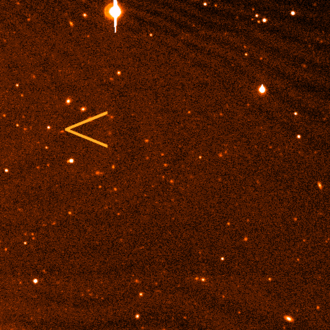
Objects at Kuiper Belt distances move very slowly. For example, Pluto orbits the Sun at about 17,000 km/hr (11,000 mph), taking 250 years to complete one orbit. These are speeds that are insufficient to maintain ven a low-Earth orbit. Comparing two image frames spaced just hours apart will find nearby asteroids moving relative to the star fields but not Kuiper belt objects. So using image frames spaced days, weeks or even months apart, they searched again. Their conclusion is that all the big Kuiper belt objects have been found.
The only possibility of finding another large KBO lies in a search of the galactic plane which is difficult due to the density of Milky Way’s stars in the field of view. The vast number of small bodies in the Kuiper belt and Oort Cloud lends itself readily to statistical analysis. Brown states that there is a 32% chance of finding another Pluto-sized object hiding among the stars of the Milky Way.
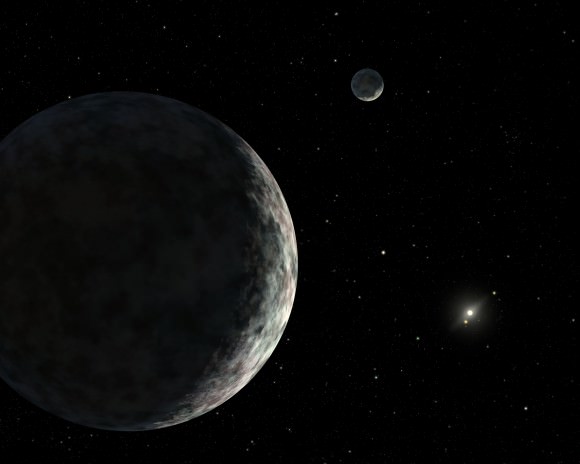
Dr. Brown also released a blog story in celebration of the discovery of the largest of the Kuiper Belt objects, Eris, ten years ago last week. Ten years of Eris, reminisces about the great slew of small body discoveries by Dr. Brown, Dr. Chad Trujillo of Gemini Observatory and Dr. David Rabinowitz of Yale Observatory.
Brown encourages others to take up this final search right in the galactic plane but apparently his own intentions are to move on. What remains to be seen — that is, to be discovered — are hundreds of large “small” bodies residing in the much larger region of the Oort Cloud. These objects are distributed more uniformly throughout the whole spherical region that the Cloud defines around the Sun.
Furthermore, Dr. Brown maintains that there is a good likelihood that a Mars or Earth-sized object exists in the Oort Cloud.
Small bodies within our Solar System along with exo-planets are perhaps the hottest topics and focuses of study in Planetary Science at the moment. Many graduate students and seasoned researchers alike are gravitating to their study. There are certainly many smaller Kuiper belt objects remaining to be found but more importantly, a better understanding of their makeup and origin are yet to be revealed.
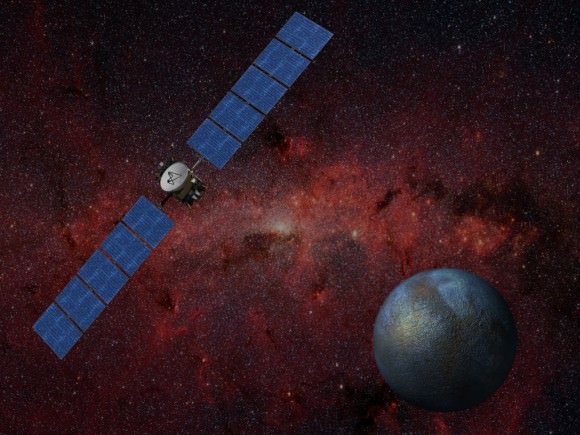
Presently, the Dawn spacecraft is making final approach to the dwarf planet Ceres in the Asteroid belt. The first close up images of Ceres are only a few days away as Dawn is now just a couple of 100 thousand miles away approaching at a modest speed. And much farther from our home planet, scientists led by Dr. Alan Stern of SWRI are on final approach to the dwarf planet Pluto with their space probe, New Horizons. The Pluto system is now touted as a binary dwarf planet. Pluto and its moon Charon orbit a common point (barycenter) in space that lies between Pluto and Charon.
So Dr. Brown and team exits stage left. No more dwarf planets – at least not soon and not in the Kuiper belt. Will that upstage what is being called the year of the Dwarf Planet?
But next up for close inspection for the first time are Ceres, Pluto and Charon. It should be a great year.
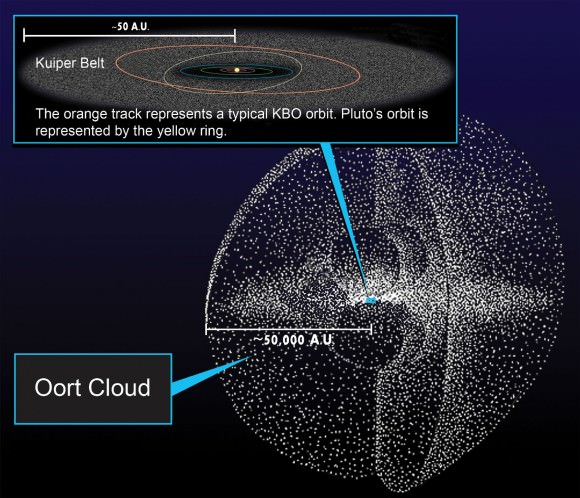
References:
A Serendipitous All Sky Survey For Bright Objects In The Outer Solar System
2015, NASA’s Year of the Dwarf Planet, Universe Today
What is the Kuiper Belt?, Universe Today

A fascinating set of finds was announced today at the 225th meeting of the American Astronomical Society (AAS), currently underway this week in Seattle, Washington. A team of astronomers announced the discovery of eight new planets potentially orbiting their host stars in their respective habitable zones. Also dubbed the ‘Goldilocks Zone,’ this is the distance where — like the tempting fairytale porridge — it’s not too hot, and not too cold, but juuusst right for liquid water to exist.
And chasing the water is the name of the game when it comes to hunting for life on other worlds. Two of the discoveries announced, Kepler-438b and Kepler-442b, are especially intriguing, as they are the most comparable to the Earth size-wise of any exoplanets yet discovered.
“Most of these planets have a good chance of being rocky, like Earth,” said Guillermo Torres in a recent press release. Guillermo is the lead author in the study for the Harvard-Smithsonian Center for Astrophysics (CfA).
This also doubles the count of suspected terrestrial exo-worlds — planets with less than twice the diameter of the Earth — inferred to orbit in the habitable zone of their host stars.
Fans on exoplanet science will remember the announcement of the first prospective Earth-like world orbiting in the habitable zone of its host star, Kepler-186f announced just last year.
The Kepler Space Telescope looks for planets used a technique known as the transit method. If a planet is orbiting its host star along our line of sight, a small but measurable dip in the star’s brightness occurs. This has advantages over the radial velocity technique because it allows researchers to pin down the hidden planet’s orbit and size much more precisely. The transit method is biased, however, to planets close in to its host which happen to lie along our solar system-bound line of sight. Kepler may miss most exo-worlds inclined out of its view, but it overcomes this by staring at thousands of stars.

Launched in 2009, Kepler has wrapped up its primary phase of starring at a patch of sky along the plane of the Milky Way in the directions of the constellations of Cygnus, Lyra and Hercules, and is now in its extended K2 mission using the solar wind pressure as a 3rd ‘reaction wheel’ to carry out targeted searches along the ecliptic plane.
Both newly discovered worlds highlighted in today’s announcement orbit distant red dwarf stars. Kepler-438 b is estimated to be 12% larger in diameter than the Earth, and Kepler-442 b is estimated by the team to be 33% larger. These worlds have a 70% and 60% chance of being rocky, respectively. For comparison, Ice giant planet Uranus is 4 times the diameter of the Earth, and over 14 times more massive.

“We don’t know for sure whether any of the planets in our sample are truly habitable,” Said CfA co-researcher in the study David Kipping. All we can say is that they’re promising candidates.”
The idea of habitable worlds around red dwarf stars is a tantalizing one. These stars are fainter and cooler than our Sun, and 7.5% to 50% as massive. They also have two primary factors going for them: they’re the most common type of stars in the universe, and they have life spans measured in trillions of years, much longer than the current age of the universe. If life could go from muck to making microwave dinners here on Earth in just a few billion years, it’s had lots longer to do the same on worlds orbiting red dwarf stars.
There is, however, one catch: the habitable zone surrounding a red dwarf is much closer in to its host star, and any would-be planet is subject to frequent surface-sterilizing flares. Perhaps a world with a synchronous rotation might be spared this fate and feature a habitable hemisphere well inside the snow line permanently turned away from its host.
The team made these discoveries by sifting though Kepler’s preliminary finds that are termed KOI’s, or Kepler Objects of Interest. Though these potential discoveries were far too small to pin down their masses using the traditional method, the team employed a program named BLENDER to statically validate the finds. BLENDER has been employed before in concert with backup observations for extremely tiny exoplanet discoveries. Torres and Francois Fressin developed the BLENDER program, and it is currently run on the massive Pleiades supercomputer at NASA Ames.
It was also noted in today’s press conference that two KOIs awaiting validation — 5737.01 and 2194.03 — may also prove to be terrestrial worlds orbiting Sun-like stars that are possibly similar in size to the Earth.
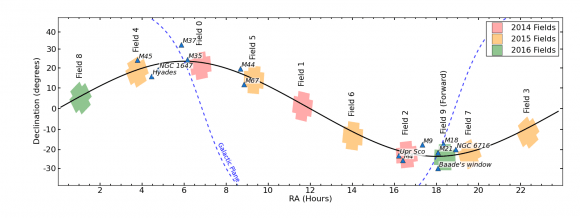
But don’t plan on building an interstellar ark and heading off to these newly found worlds just yet. Kepler-438b sits 470 light years from Earth, and Kepler-442b is even farther away at 1,100 light years. And we’ll also add our usual caveat and caution that, from a distance, the planet Venus in our own solar system might look like a tempting vacation spot. (Spoiler alert: it’s not).
Still, these discoveries are fascinating finds and add to the growing menagerie of exoplanet systems. These will also serve as great follow up targets for TESS, Gaia and LSST survey, all set to add to our exoplanet knowledge in the coming decade.
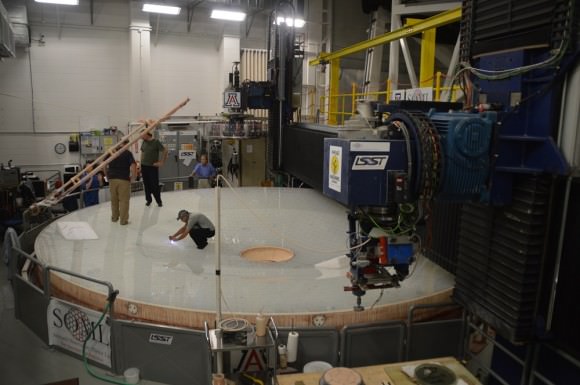
And to think, I remember growing up as a child of the 1970s reading that exoplanet detections were soooo difficult that they might never occur in our lifetime… now, fast-forward to 2015, and we’re beginning to classify and characterize other brave new solar systems in the modern Age of Exoplanet Science.
-Looking to observe red dwarf stars with your backyard scope? Check out our handy list.